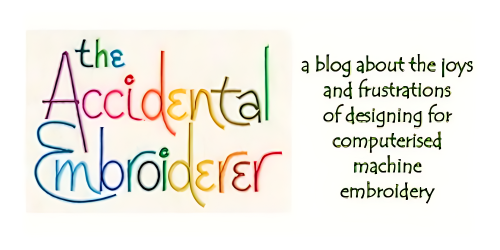Pieced embroidery
The thing that annoys me most about computerised machine embroidery is that you’re restricted to such a small field (a maximum size of 7 ¾ x 11 ¾ inches on my machine, which is pretty small). So what do you do if you want to make a larger panel? Most professional digitisers will usually just chop up a large picture arbitrarily into small squares that will fit into the embroidery field, digitise them separately, stitch them together to make a large panel, and hope for the best. This seems to me to be a pretty crude approach, and one that shows no respect for the design. But piecing seems to be about the only way you can make a large embroidered panel so I’ve been working on the best ways to do it
Sometimes you can draw a design that has only minimal attachment between the “squares” that will eventually make up the design, and this will make the pieced panel look more natural. One example of this is a long thin design, where the adjoining pieces need to meet only at one spot
This Audubon-inspired panel is made up of separate squares stacked on top of each other, drawn in such a way that they need to be aligned only at the spot where the stem of the plant runs from one square into the next
Or you can draw a design in such a way that it fits naturally into separate blocks, with few parts that run from one segment into the next.
From the beginning, this bush with birds was drawn and digitised to fit into four adjacent squares
However this is not always a suitable solution to the problem: some designs do not allow you to chop them up into squares and reassemble them so easily
As far as I can see, there are two other things you could try. First, you can break up a design into sections where the “joins” fit seamlessly into the design so that you scarcely notice them when they’re stitched. Or second, you can design something that is deliberately made up of small units, so the separate parts look quite natural when they’re stitched together. I’ve been working on both these techniques and will be putting some examples up in the coming weeks
